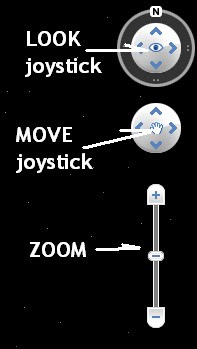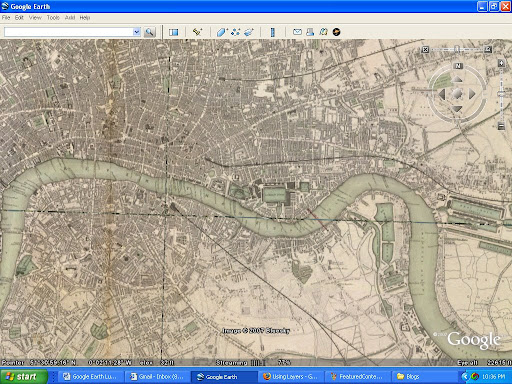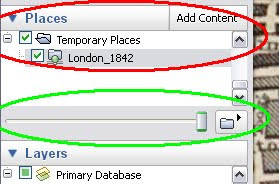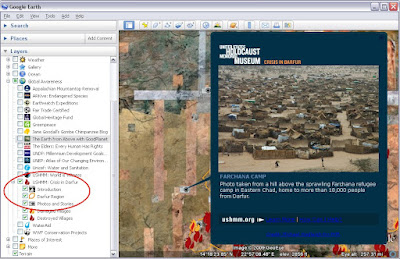This just in from Alexander Chaucer up at Skidmore College...
Tuesday, October 30, 2007
ANNOUNCEMENT - Call for Presenters for the Skidmore GIS Conference
Wednesday, October 03, 2007
Google Earth Lunchtime Demonstration
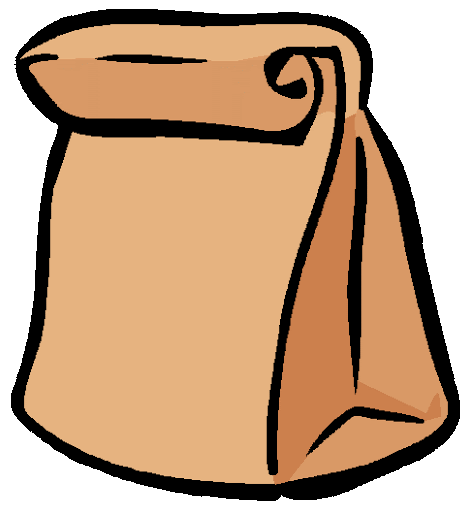 This lunchtime demo will highlight how to use Google Earth for an academic audience. Like having a globe on your computer, Google Earth is an easy-to-use tool for showing places around the world while in the classroom. With Google Earth you can zoom in to any location and view the landscape, cityscape, topography, photographs taken on the ground, and so much more. You can create place marks to prepare for class or share with students to bring a geospatial context to the lecture.
This lunchtime demo will highlight how to use Google Earth for an academic audience. Like having a globe on your computer, Google Earth is an easy-to-use tool for showing places around the world while in the classroom. With Google Earth you can zoom in to any location and view the landscape, cityscape, topography, photographs taken on the ground, and so much more. You can create place marks to prepare for class or share with students to bring a geospatial context to the lecture.
Getting started with Google Earth

Before you do anything, make sure you download Google Earth.
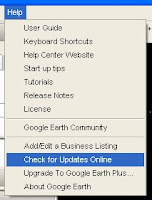
Navigation
Or you can just navigate (spin the globe) by panning with the hand tool.
Searching
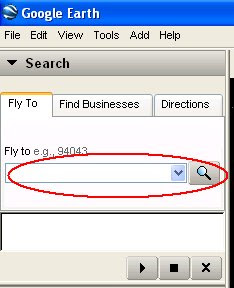
You can zoom to most any location by using the Search or Fly to area on the left side of the map window. In the text line shown circled in red above, type in either a place name (city, country, geographic feature, for instance) or type in a longitude and latitude, (you can get those from Wikipedia, for example look at Rio de Janeiro and the Coordinates on the right hand side.) Copy and Paste the latitude and longitude into the Search line and click search.
Viewing Layers
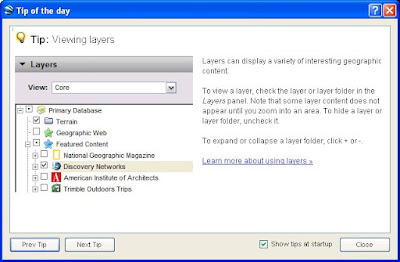 On the lower left hand side of the window you will see Layers. There are many intriguing layers to click on and off, some of which are really worth exploring. Here’s what to look for:
On the lower left hand side of the window you will see Layers. There are many intriguing layers to click on and off, some of which are really worth exploring. Here’s what to look for: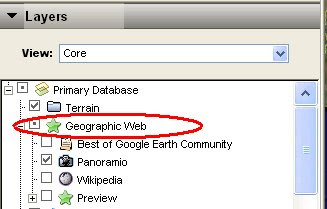 Under Geographic Web (next one under Terrain), take a look at Panoramio and Wikipedia by zooming into an area of interest and checking these boxes. If you do not see Panoramio and Wikipedia, click on the plus sign next to the name Geographic Web. Panoramio refers to the web site that houses millions of geo-located photographs that show up as little blue squares on the map. When you click on them, you get to see what the scene looks like on the ground. These photographs are not taken by Google but by people like you and me - user-generate content. Wikipedia, which are white square with a 'W' inside, will refer you to a web page with information about a variety of things.
Under Geographic Web (next one under Terrain), take a look at Panoramio and Wikipedia by zooming into an area of interest and checking these boxes. If you do not see Panoramio and Wikipedia, click on the plus sign next to the name Geographic Web. Panoramio refers to the web site that houses millions of geo-located photographs that show up as little blue squares on the map. When you click on them, you get to see what the scene looks like on the ground. These photographs are not taken by Google but by people like you and me - user-generate content. Wikipedia, which are white square with a 'W' inside, will refer you to a web page with information about a variety of things.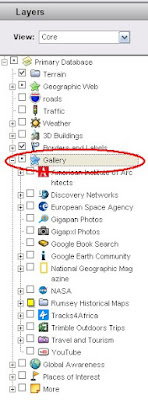 Check out the Gallery layers (circled in red above). Don't click them all on at once! Click on and off the things that interest you and see what you see. One of my favorites is the David Rumsey Historical Maps site. Double-click on Map Finder and check out London in 1843. Click on the icon that pops up in London, then click on the old map in the balloon.
Check out the Gallery layers (circled in red above). Don't click them all on at once! Click on and off the things that interest you and see what you see. One of my favorites is the David Rumsey Historical Maps site. Double-click on Map Finder and check out London in 1843. Click on the icon that pops up in London, then click on the old map in the balloon. When you click on the circle next to London 1843 under the Rumsey Historical Maps layer, it can take a few seconds to draw the map. Zoom in to a part of London, highlight by clicking once on London 1843 (you'll find the map in the Places layer, under Temporary Places (circled in red), and then use the slider bar (shown circled in green above) to set the transparency. You can see what London looks like today and what it looked like in 1843. Turn off and on the Panoramio photograph layer to see what has changed, as well.
When you click on the circle next to London 1843 under the Rumsey Historical Maps layer, it can take a few seconds to draw the map. Zoom in to a part of London, highlight by clicking once on London 1843 (you'll find the map in the Places layer, under Temporary Places (circled in red), and then use the slider bar (shown circled in green above) to set the transparency. You can see what London looks like today and what it looked like in 1843. Turn off and on the Panoramio photograph layer to see what has changed, as well. The last layer that I want to mention is the Global Awareness layer. Rich with data and projects, and one of great interest shows on-the-ground information on Darfur. The layer is called USHMM: Crisis in Darfur.
The last layer that I want to mention is the Global Awareness layer. Rich with data and projects, and one of great interest shows on-the-ground information on Darfur. The layer is called USHMM: Crisis in Darfur.
Measure Tool

The ruler tool (circled in red above) can be useful for measuring distances. The Google Earth standard version (the free version) allows you to measure a line or a path. If you measure a path, you click along the path that you want to measure. There are a variety of measurement units to choose.
Setting Up Placemarks

You can easily set up a ‘tour’ ahead of class time by using place marks. Find a location that you want to discuss and then click on the thumbtack icon from the toolbar (circled in red above).
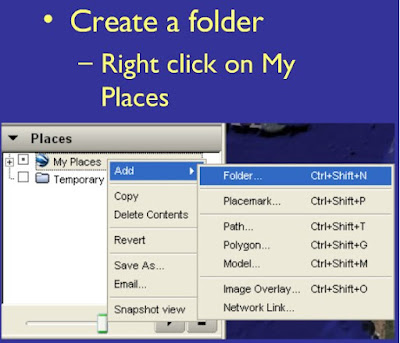 Before you begin setting up Placemarks, create a folder by right clicking on My Places and then select Add -> Folders. You'll place all of your placemarks in this folder, so give it a name. As a default, a yellow pushpin thumbtack icon will be placed in the middle of your map window. This image below shows a purple arrow. You can change the icon.
Before you begin setting up Placemarks, create a folder by right clicking on My Places and then select Add -> Folders. You'll place all of your placemarks in this folder, so give it a name. As a default, a yellow pushpin thumbtack icon will be placed in the middle of your map window. This image below shows a purple arrow. You can change the icon.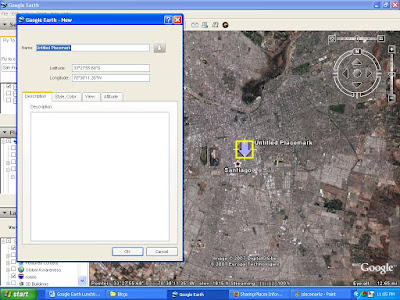 While you are in ‘edit’ mode, there will be a yellow frame around the place mark icon. Type in a title (if you like) for the place mark and type in a description (also optional) and click OK and you then have a place mark saved of the location that you chose. You can always get back to edit mode by right-clicking on the placemark icon and choosing Properties. The yellow edit frame will show up again.
While you are in ‘edit’ mode, there will be a yellow frame around the place mark icon. Type in a title (if you like) for the place mark and type in a description (also optional) and click OK and you then have a place mark saved of the location that you chose. You can always get back to edit mode by right-clicking on the placemark icon and choosing Properties. The yellow edit frame will show up again.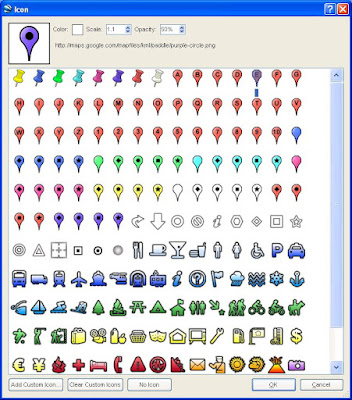
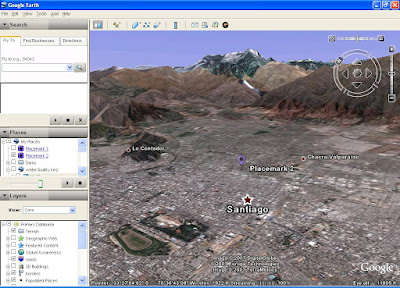
Sometimes the best way to view a place is not like a bird, flying over a flat-lying map and with North as up. If you zoom in a little, tilt the view and rotate the angle, sometimes a place is much more interesting.
When you are done with your placemarks, you can save the folder with your place marks as a KMZ (stands for Keyhole Markup Language Zipped file) file and show it in class on the classroom computer or share it with students through Blackboard or Vspace or email or on the Google Earth BBS. Click on this link to see how saving place marks is done.
Adding a Polygon
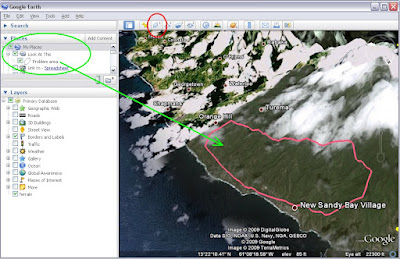 You may wish to create your own map of an area. You can use the Polygon function (circled in red) to outline an area that you're interested in sharing. Above I have created a polygon and placed it in a folder called Look at This and called the polygon Problem Area (circled in green). You can now send this to whomever you wish. Notice that the line follows the shape of the topography.
You may wish to create your own map of an area. You can use the Polygon function (circled in red) to outline an area that you're interested in sharing. Above I have created a polygon and placed it in a folder called Look at This and called the polygon Problem Area (circled in green). You can now send this to whomever you wish. Notice that the line follows the shape of the topography.Adding Your Own Map

First, create a folder in My Places and give it a name. Then click on the Image Overlay icon.
In Google Earth zoom to Israel and orient your window to align at about the same geographic extent as the map of Israel that you have. Click on the Image Overlay icon in the tool bar (circled in red above).

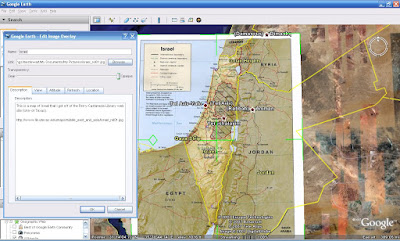
After you’ve moved, rotated and stretched your map to be just the way you like it, you can also add some content in the description area, move the Transparency bar back to Opaque and click OK. Now you have a map to share. Similar to the Tour above, you can share your map with students and colleagues as a saved KMZ file. Save the folder that contains your map.
Web Resources
 Finally, if you want to find out some more information on Google Earth, there are many terrific resources out there for educators created by educators. Sometimes, you do not need to reinvent the wheel when creating a place mark. A good place to start is Vassar’s GIS blog where we’ve compiled many links to Google Earth and other virtual globe materials and information.
Finally, if you want to find out some more information on Google Earth, there are many terrific resources out there for educators created by educators. Sometimes, you do not need to reinvent the wheel when creating a place mark. A good place to start is Vassar’s GIS blog where we’ve compiled many links to Google Earth and other virtual globe materials and information. Scroll down this blog page and you can see that there are links to the variety of virtual globes available (at least the ones I’m familiar with) under the Virtual Globes heading.
Scroll down this blog page and you can see that there are links to the variety of virtual globes available (at least the ones I’m familiar with) under the Virtual Globes heading.
Right under the Virtual Globes links are the links to Tools for Teaching with Google Earth. Here are some great links. The first one listed include all the KMZs I’ve made for faculty members.
And you should check in with the larger Google Earth BBS and do a search of a place or subject you are interested in. There might be something already out there. All the rest of the links are still active, I checked them when I wrote this short tutorial, and I highly recommend them. There are too many great educational Google Earth links to go into detail on each.
All the rest of the links are still active, I checked them when I wrote this short tutorial, and I highly recommend them. There are too many great educational Google Earth links to go into detail on each.
If you have any questions, please get in touch with me, Meg Stewart. I’ll help you out.
